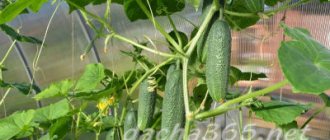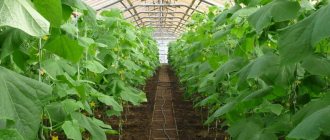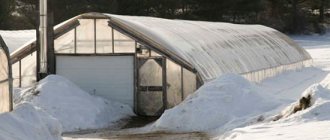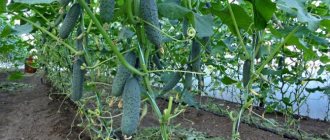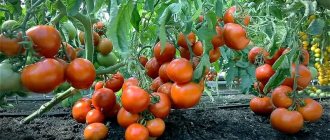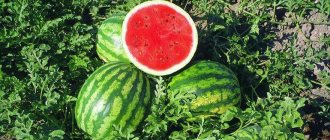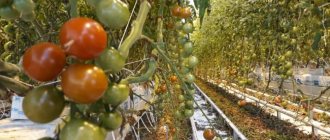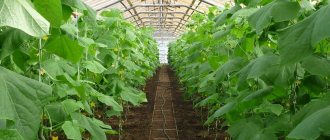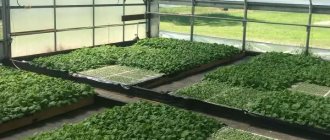When grown, cucumbers love warmth, light and moisture. Watering is of great importance to them. If there is insufficient moisture, the plant withers, its growth stops, and the ovaries may fall off. However, excess supplied water also has a negative effect on the crop - aeration of the root system decreases, root hairs and young shoots begin to die, stems rot, and fruits become deformed. It is necessary to create a proper watering schedule. During some periods of development, cucumbers require less moisture, and during others more.
What are the features of irrigating cucumbers in a greenhouse?
Cucumbers are a moisture-loving vegetable crop, so you need to water the bushes regularly. In hot weather, it is not only the soil that needs moisture . Fruits and leaves of plants also require watering.
Important! When irrigating, pour water strictly between the rows so as not to wash away the soil at the roots.
A polycarbonate greenhouse is ideal for growing cucumbers . It has light transmission, retains heat, and protects fruits from wind and rain. The crop ripens faster than in open ground.
For plants to grow well , the temperature in the greenhouse should be +20...+26°C. Only in this case the plant will not stop in its development.
water into a polycarbonate greenhouse in small portions , avoiding stagnation of liquid at the roots. The soil should be loose.
Interesting things on the site:
Why don't cucumbers grow in a greenhouse?
Soil requirements for cucumbers in a greenhouse
Why do cucumber ovaries turn yellow?
Choosing the right variety
Growing cucumbers indoors means that pollinating insects will not have access to the plant's flower stalks. Therefore, for this case, choose varieties that can self-pollinate or those that do not need pollination at all - parthenocarpic. These properties are indicated on the seed package.
It is important to distinguish cucumber varieties from their hybrids. When planting varietal types of vegetables, their properties will be repeated from year to year, and it is possible to obtain your own seeds from the most successful harvest.
When using hybrids, self-collected cucumber seeds do not carry the properties and qualities of the previous harvest. This means that hybrid seed must be purchased annually.
Let's consider some varieties and hybrids suitable for growing in shelter:
- Adam F1. A hybrid from Holland with the ability to self-pollinate and obtain a rich, early-ripening harvest. The first vegetables can be harvested after 1.5 months, and the fruiting period is quite long. Under favorable conditions, cucumbers are tied in 5-7 pieces. in one node. The fruits are small in size, dark in color with small spines. Suitable for preparation and fresh consumption.
- Herman F1. A wonderful hybrid of Dutch selection. Very early, with a long fruiting period. Small cucumbers develop in bunches of 6-7 pieces. The fruits are juicy and dense. The hybrid is resistant to temperature changes and diseases. Good fresh and canned. Planting in open ground and greenhouses is possible.
- Son-in-law F1. Parthenocarpic hybrid. Fruits develop in nodes of 3-7 pieces. up to 10 cm long. Can be harvested at any stage of maturity. Cucumbers are delicious, yield up to 6 kg per plant. Resistant to powdery mildew and root rot. Adaptable to sudden changes in weather conditions.
In addition to the presented species, it is possible to sow seeds of the following cucumber varieties: “Metelitsa”, “Prestige”, “Ararat”, “Tatyana”, “Fed Papa”, “Everyone is Envy”, etc.
How to water cucumbers in a greenhouse manually
The manual method of irrigating vegetables is used in a small garden bed . When watering plants by hand, gardeners use a watering can and hose.
This method is simple and does not require serious financial investments, since every gardener has a watering can and hose. But the manual irrigation method is time-consuming.
Important! If you water the cucumbers with a hose, make sure that the water pressure is low, otherwise there is a high risk of washing away the soil at the roots.
Important Tips
Advice from experienced summer residents:
- Water the cucumbers often, but do not exceed the permissible dosage.
- Do not apply water to the root; it is very difficult to cover it later, although it is possible.
- The water temperature should be close in value to the ground temperature.
- Pay attention to the foliage of plants, do not miss the initial stage of “withering” of greenery.
- During the growing season, the soil at the base of the plant should be dry.
- To prevent plants from overheating in the greenhouse, spray the windows on the outside of the greenhouse with a solution of water and chalk.
Watering cucumbers is the most important point in caring for the crop. Without the proper amount of water, vegetables grow tasteless and too bitter.
0
0
Copy link
Water requirements
Water for watering cucumbers should be warm . Optimal temperature: 20-24°C. This temperature will provide the fruits with comfortable conditions for growth.
Important! Do not use boiled water; it does not contain the minerals plants need. It is better to use settled liquid for watering vegetables.
For convenience, water can be stored in special containers (barrels). During the day it will heat up in the sun, and in the evening you can water vegetables with it.
Make sure that there is no excess salt and fluoride in the liquid . Water should always be clean and not hard. Do not use dirty water for irrigation.
Reference. If the water is hard, it needs to be softened. Add 5 teaspoons of wood ash to 10 liters of water.
Soil preparation
Already at the construction stage of the greenhouse, it is worth determining a place for planting cucumbers. The site should be sunny and away from tall trees and buildings that can create shadows.
The inside of the greenhouse for growing cucumbers must be equipped with plant supports
The material for the greenhouse should be chosen that is durable, has high light transmittance and has high thermal insulation qualities, especially if early sowing is planned. Polycarbonate greenhouses have these properties. You can build it from glass or cover the frame with film. However, the film quickly deteriorates and the greenhouse will need to be covered next season.
Soil preparation consists of the following stages:
- dig up the ground. At the same time, it is worth removing all the roots of weeds;
- if the acidity of the soil is high, you can add chalk or quicklime to the soil during digging;
- add a solution of copper sulfate to the soil. This will disinfect it from many pathogens. If there is a possibility of fungal spores remaining in the soil, you can remove the upper part of the soil in which they are located (up to 7 cm);
- lay the substrate prepared in advance. The following composition is considered optimal: peat, humus, fertile soil, sawdust. Instead of sawdust, you can add manure, but you should not add other fertilizers to the soil.
Important! Adding wood ash will help reduce the risk of disease. It can be added systematically, at any stage of preparation.
You can tighten the wire in advance or prepare trellises; bushes will be tied to them as they grow.
Frequency, timing and volume of irrigation
Morning and evening are the optimal time for watering cucumbers . During the daytime, the drops remaining on the leaves become a kind of magnifying glass. The sun's rays penetrate through them and burn the leaves and roots of plants.
Closer to night it is also not recommended to irrigate cucumbers, as the temperature drops. Due to waterlogging in cold weather, the roots will begin to rot.
The frequency and volume of watering depend on the growth phase of the plant and climatic conditions. The older the vegetable crop, the more water it requires . Adult plants need watering every other day. Approximately 10 liters of liquid are added to each bush.
The nuances of watering at different times
The irrigation regime depends on weather conditions, the phase of plant development and soil conditions.
Plant development phases:
- landing;
- bloom;
- fruiting.
After planting cucumbers
Most often, plants are planted as seedlings in greenhouses. After being transferred to the soil, plants need abundant watering . The seedlings should take root well in the soil.
After this, young cucumbers are watered regularly. Watering in a polycarbonate greenhouse is carried out once every five days. 3-5 liters of water are used per 1 m². Thanks to this watering, cucumbers will form ovaries faster.
During flowering
During flowering, the plant is watered more often - every 3-4 days . During this period they form ovaries. About 10 liters of water are consumed per 1 m².
During fruiting
During fruiting in the summer months, cucumbers are watered every other day or every day . The hotter it is outside, the more often the soil is moistened. For one bush use 7-10 liters of liquid.
During the heat
In hot weather, cucumbers especially need watering . In this regard, the frequency of irrigation is increased. During flowering and fruiting, if it is hot, cucumbers are watered every day.
At temperatures above 26°C, it is recommended to additionally moisturize the cucumbers by sprinkling (spraying water with special mechanisms). This prevents the ovaries from wilting. 1-1.5 liters of water are used per 1 m². The procedure is carried out in the morning and evening.
In rainy weather
In rainy weather, the frequency of watering decreases ; at this time, the soil and air in the greenhouse have increased humidity. Gardeners need to monitor these indicators. When temperatures drop, the soil becomes waterlogged, which contributes to root rot and plant death.
In rainy weather, cucumbers are watered in the morning . Make sure the soil does not dry out.
Signs of lack of moisture
Cucumber is a tropical plant that requires warmth, sufficient light and moisture for full development. A crop with large leaves evaporates a lot of liquid and requires abundant watering.
Signs indicating a lack of moisture in the soil when growing cucumbers:
- slowing down the growth of the above-ground part of the plant;
- formation of a weak root system;
- loss of turgor in shoots, wilting of foliage during midday hours;
- yellowing, drying of leaves and lashes;
- the formation of predominantly male flowers on the bushes;
- mass abscission of ovaries;
- decrease in yield - the resulting fruits are small, deformed, with an increased content of the substance cucurbitacin in the pulp, which gives cucumbers a bitter taste.
Excessive watering causes no less harm to the cucumber: the resulting crust interferes with air exchange, and the root system does not receive oxygen. Stagnation of moisture in the soil leads to rotting of the roots.
How to make a drip irrigation system
The drip method is a good way to irrigate vegetables .
It does not require large investments. Special pipes with holes are installed on the site .
Through them, the liquid flows directly to the plant. This method not only saves water and time, but also allows you to control the volume of incoming liquid. A barrel of water, where the liquid for irrigation is heated in the sun during the day, is placed on an elevated place. A special hose is attached to the barrel .
Using a tap, you regulate the volume of incoming water. After the tap opens, the liquid flows through the pipes directly to the plant. This method does not allow the soil to erode around the roots.
Formation of bushes
Temperature conditions are very important for the proper formation of seedlings. Planting is carried out at daytime levels up to +20°C and at night +17-18°C. After fruiting begins, the temperature level should be higher than a couple of degrees. Sudden changes should be avoided, otherwise the fruits will taste bitter.
Important! Not only temperature conditions, but also any stress causes a defensive reaction in cucumbers, which is why they acquire a bitter taste. Stress is caused by lack of moisture, uneven application of mineral fertilizers, etc.
As the bush grows, you need to tie the cucumbers to the trellises with twine or soft rope. It is better to do this at each internode.
Tie the bushes to supports so that the fruits do not lie on the ground
The bush should be formed according to the following rules:
- The first lateral shoots need to be removed.
- Shoots grow from the axils; it is better to pinch them off above the first leaf.
- The upper shoots can be pinched under the second leaf.
- Pinch off the top after the bush has grown above the trellis.
Many experts recommend picking the flowers of the first ovary. It is believed that these cucumbers ripen slowly, so you should not waste the nutrients. It is better to direct them to faster formation of the bush.
Advice from experienced summer residents
To get a good harvest and avoid common mistakes, you should follow the rules for watering cucumbers. Experienced summer residents can tell you how best to irrigate vegetables:
- To prevent cucumbers from becoming bitter, water them regularly. Do not allow the soil to dry out. The water should be warm. Combine with fertilizing watering.
- A white coating on the soil surface indicates that the frequency of watering and the volume of water should be reduced.
- In hot weather, you can cool the greenhouse structure using a regular chalk solution. They irrigate the walls of the greenhouse with it.
- Do not water plants directly at the root. This way the soil is eroded. Moisture stagnates at the roots and mold appears. Water the vegetables in the grooves near the plant, which are dug at each bush.
- For drip irrigation, a regular bottle is suitable. Several holes are made in the lid, the bottom of the container is cut off, and the neck is placed in the ground next to the plant. Each bush should have its own container. After this, the bottle is filled with water. Through the holes, the liquid reaches the roots of the vegetable crop.
- If the plant suffers from a fungal infection, the sprinkling method is excluded. Water with a watering can or by drip.
- Iodine and urea will protect plants from infections. Add them to the liquid when irrigating vegetables.
Transplanting
You can prepare the seedlings yourself by growing them at home or planting cucumbers in a greenhouse with seeds. Many experts agree that planting seedlings is more effective. Such a seedling will be hardened and will grow faster.
Only strong and hardened seedlings can be planted in a greenhouse.
Planting begins in May, when the earth has warmed up. To get an early harvest, they are planted in April, but two weeks before that the beds are covered with film. When forming ridges, it is worth assessing the future size of the bush. It is recommended to make 1-2 rows if the width of the bed is 1 m. In each row, make deep holes every 30-40 cm, which need to be watered abundantly. Planting at a smaller distance may limit light access to some bushes, and the seedlings will interfere with each other as they grow.
If your seedlings grew in peat pots, plant them with them
Planting is carried out directly in peat pots. Otherwise, the root may be damaged, causing the bush to develop slowly. Planting cucumbers requires some attention. In particular, the root collar should not be allowed to touch the soil. This will provoke diseases caused by microorganisms that fall on the neck during watering.
